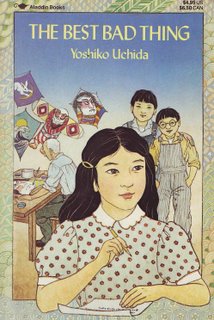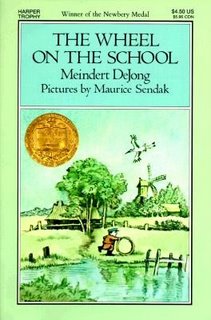
 (Note: This a special series of blog posts. See the entire list of posts on Patti Abbott’s website.) (Note: This a special series of blog posts. See the entire list of posts on Patti Abbott’s website.)
Have you ever entered an old childhood haunt and been surprised how small the confines were? How a building actually was a little less majestic than you had imagined? Or perhaps how different the place is as an adult compared to your experience as a child?
I had a similar thought as I reread one of my picks for a forgotten book, THE WHEEL ON THE SCHOOL, by Meindert DeJong, a Dutch immigrant who produced a number of award-winning books in the 1950s and ‘60s. I think that as a grade student, I was working my way through Newbery Award winners when I came across THE WHEEL ON THE SCHOOL, which won the medal in 1955. I remember being captivated by the tale of children trying to attract storks back in their aging Dutch fishing village. How were they going to do it? By finding a wooden wheel they could attach to a roof for nesting purposes, of course. I loved being transported to a time of wooden shoes and simpler times.
My more recent reread of the book resulted in new discoveries. One was the pictures were drawn by Maurice Sendak (Sendak had apparently illustrated at least half a dozen of DeJong’s books). The other was that the book was dealing with themes of a rapidly aging society, man versus nature, and mobilization of a “sleeping” community. And the star of the story was a little girl, the only female out of a class of all boys. In this sense, the book was echoing very contemporary concerns, but I was surprised by the pace of the book—very slow and meandering at times. Today’s young people, I imagine, would have to adjust their expectations when tackling THE WHEEL ON THE SCHOOL.
I suppose that I related to the story and characters because as an only child for eight years, I spent a great deal of time with adults. I think also I was a more attentive reader back then. Right now I’ve been immersed in mysteries by Scandinavian authors published in translation and I can’t help but wonder if THE WHEEL ON THE SCHOOL helped to open my interest in that part of the world.
In terms of a book closer to home (at least my home), THE BEST BAD THING by Yoshiko Uchida is one of my favorite middle-grade books. I was not introduced to THE BEST BAD THING until I was a young adult. The book was published in 1983—heralding a new era of multicultural publishing for children. THE BEST BAD THING is set in East Oakland in the 1930s, but it feels very fresh and timeless. A Japanese American teenager, Rinko Tsujimura, must spend part of her summer helping an eccentric widow. Uchida just does a masterful job in weaving culture seamlessly into her work. Her voice is so natural without being too cutesy or maudlin. Uchida is definitely one of my literary role models as she doesn’t necessarily attempt to be didactic in her work. She just tells the story of people who happen to be Japanese American. Thank you, Yoshiko.
THE BEST BAD THING, by the way, was adapted into a public television show, a joint venture between a Pittsburgh station and NHK, a Japanese public television station. In one of the starring roles was George Takei, who was really quite wonderful in a very subdued non-Sulu type performance.
Both THE WHEEL ON THE SCHOOL and THE BEST BAD THING have their pulse on community and inter-generational relationships—two topics that happen to fascinate me. Labels: Friday's Forgotten Books, Meindert DeJong, The Best Bad Thing, The Wheel on the School, Yoshiko Uchida |


Lovely site, Naomi and great reviews. We'll have to do a kid's version of it again soon.